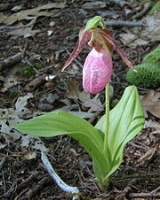
Cypripedium acaule
Encyclopedia
Cypripedium acaule is a member of the orchid genus Cypripedium
. Members of this genus are commonly referred to as lady's slipper orchids
. First described in 1700, C. acaule is commonly referred to as the Pink Lady's Slipper, Stemless Lady's-slipper, or Moccasin Flower. The Pink Lady's Slipper is the provincial flower of Prince Edward Island
, Canada.
If the plant's blossom does not cycle through, it will not regenerate; for this reason, it is recommended that the flower not be picked.
An alba variety exists which has a white lip instead of a pink one.
rather than a round opening. The plant consists of two plicate leaves near the ground. From between those leaves sprouts a long, pubescent stalk that bears a single pink flower. The sepal
s and petal
s tend to be yellowish-brown to maroon with a large pouch that is usually some shade of pink but can range from nearly magenta to pure white.
. This widespread species can be found in a wide variety of environments, from coastal plains, to pine barrens, to mountaintops.
Cypripedium
Cypripedium is a genus of 47 species of lady's-slipper orchids native to temperate and colder regions of the Northern Hemisphere.Some grow in the tundra in Alaska and Siberia, which is an unusually cold habitat for orchids. They can withstand extreme cold, growing under the snow and blooming when...
. Members of this genus are commonly referred to as lady's slipper orchids
Lady's Slipper
Lady's slipper orchids, lady slipper orchids or slipper orchids are the orchids in the subfamily Cypripedioidea, which includes the genera Cypripedium, Mexipedium, Paphiopedilum, Phragmipedium and Selenipedium...
. First described in 1700, C. acaule is commonly referred to as the Pink Lady's Slipper, Stemless Lady's-slipper, or Moccasin Flower. The Pink Lady's Slipper is the provincial flower of Prince Edward Island
Prince Edward Island
Prince Edward Island is a Canadian province consisting of an island of the same name, as well as other islands. The maritime province is the smallest in the nation in both land area and population...
, Canada.
If the plant's blossom does not cycle through, it will not regenerate; for this reason, it is recommended that the flower not be picked.
An alba variety exists which has a white lip instead of a pink one.
Description
Unlike most other members of Cypripedium, the pouch of C. acaule opens in a slit that runs down the front of the labellumLabellum
Labellum is the Latin diminutive of labium, meaning lip. These are anatomical terms used descriptively in biology, for example in Entomology and botany.-Botany:...
rather than a round opening. The plant consists of two plicate leaves near the ground. From between those leaves sprouts a long, pubescent stalk that bears a single pink flower. The sepal
Sepal
A sepal is a part of the flower of angiosperms . Collectively the sepals form the calyx, which is the outermost whorl of parts that form a flower. Usually green, sepals have the typical function of protecting the petals when the flower is in bud...
s and petal
Petal
Petals are modified leaves that surround the reproductive parts of flowers. They often are brightly colored or unusually shaped to attract pollinators. Together, all of the petals of a flower are called a corolla. Petals are usually accompanied by another set of special leaves called sepals lying...
s tend to be yellowish-brown to maroon with a large pouch that is usually some shade of pink but can range from nearly magenta to pure white.
Range
C. acaule can be found in the eastern third of the United States and north into Canada, coming very close to the Arctic circleArctic Circle
The Arctic Circle is one of the five major circles of latitude that mark maps of the Earth. For Epoch 2011, it is the parallel of latitude that runs north of the Equator....
. This widespread species can be found in a wide variety of environments, from coastal plains, to pine barrens, to mountaintops.
Habitat
C. acaule requires acidic soil but tolerates a range of shade and moisture, though it prefers at least partial shade and well-drained slopes. It is usually found in pine forests, where it can be seen in large colonies, but it also grows in deciduous woods. Because of a fungus association needed for growth, and the high acid this plant needs, C. acaule is difficult to grow in the average garden and is unlikely to survive attempts at transplantation.Frequency
This species is common in parts of the northern United States and adjoining provinces of Canada, but it is considered endangered in Illinois and Tennessee, Vulnerable in New York, and Unusual in Georgia.Common names
- Pink Lady's Slipper
- Moccasin Flower
- Two-leaved Lady's Slipper
- Stemless Lady's-slipper
External links
- Pink Lady's Slipper, borealforest.org
- Pink Lady's Slipper, Ontario Wildflowers
- Pink Lady's Slipper, Nature North
- Cypripedium acaule, Digital Flora of Newfoundland and Labrador

